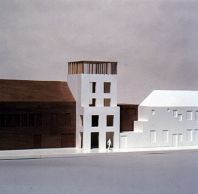
Building in Groningen
Model
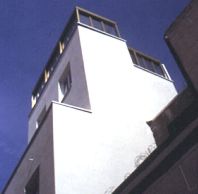
Building in Groningen
Upward oblique view
Conversation with Tony Fretton
by Davide Vargas
I met Tony Fretton at his office in Old Street in London, just after the first American attack to Afghanistan. The first thing I thought was: Only in this way we can check the tragic moment we are living, with the culture and a serious work. In this office the crash of bombs is far, but it doesn’t mean isolation, on the contrary here they work for the civilization.
A man with a grey sweater without a shirt (in London nobody wears the shirt under the sweater) came to meet me. I entered an open space where in the middle there was a table with some computers on and a few collaborators. All around, a lot of plastic models, some of them refined and others in progress; not many designs and not much mess. Books and magazines were piles placed on the floor.
He gave me Indian tea, chips and some orange juice.
He talked about many things, in a calm tone, showing me some pictures and plastic models. My English gave me the opportunity to catch the main points.
One. He is first of all an architect, then a politician.
I could say, for example, that we identify a social background by noticing things and draw them to people’s attention through what we do with the building, or that the politics in the buildings and objects that we make are libertarian.
The subject occurs in all his architectures; from the Lisson Gallery which becomes a quality seed for the urban context, till the apartment Groningen where the main subject is the use and the changes by the tenants.
|
Building in Groningen |
Building in Groningen |
Two. He loves some architectures and architects; they are very important for his language (he often used this word). For example Siza, Asplund, the palace at Urbino, the first Gehry or Villa Malcontenta.
Buildings wich have preoccupied me have a presence in this work: the palace at Urbino, Dutch and Flemish houses where the windows exceed the area of the masonry, Le Corbusier’s Maison Clartè in Geneva, Palladio’s Villa Malcontenta and many buildings by Alvaro Siza and other architects who are working now. For me the architecture of the past and present exists in the present, always revealing its radicalness and capacity to talk about the heart of human experience.
In his work there is a continuous tension between the planning language and, I seem to understand, the basis of his historical heritage which he refers to. First of all the Italian architecture of the fifteenth and sixteenth century.
Three. He has not much money. And for this reason all those architects who make an effort to keep a quality often undervalued, like him.
He showed me his last plans and often used the word "abstraction".
Close to a plastic model of a plan for the extension of an existing building on a hill, he explained to me how the project was born in connection with the perception of the architecture from different points of view while he moved to show me the view that one would catch. These the reasons of his planning choices, such as the joined construction, defined by glasses - to catch the interior life – or such as the mimetic rebuilding, of a conceptual kind I suppose, of a part of the building so to realise a sort of placed on top arcades.
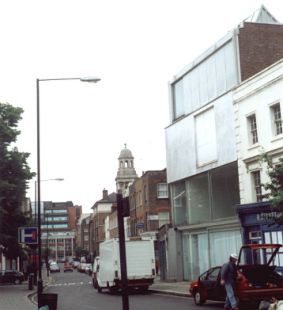
Lisson Gallery in London
Then he showed me the plastic model of a small gallery where the subject is the roofing and the light which filters through skylights. The subject occurs in his plans from the Lisson to the Centre for Visual Arts: lights cuts and shades which soften the outlines walls, corners and edges as in a picture.
Another plastic model was the section of a space in height, surrounded by some balconies: the subject is emptiness lightened from above, apart from its function; a kind of bright flexibility.
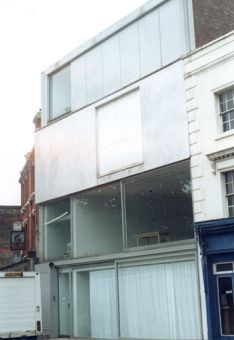
Lisson Gallery in Londra
His last work is a house in Tite Street, in the district of Chelsea, the heartland of London. A big and rare planning event.
In that street Whistler and the painters of the same aesthetic movement born just there, and Oscar Wilde lived.
You can get there crossing the Thames through a bridge that seems a fun-fair with an Oriental flavour. A sweet reflection on the water. You must love river as you love a woman to make a bridge like this.
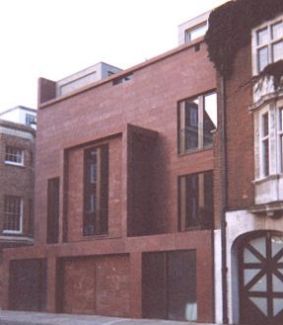
House in Tite Street
District of Chelsea, the heartland of London
You greet Sheradzade and you meet Palladio.
As all Fretton’s plans, the main tension occurs between the modern conception and the historical references. That’s why a complex work comes out, where the manipulation of history is subtle.
The house is a monolithic block of reddish-brown French limestone whose façade overlooks Tite Street placed around aedicule, unequivocal memory of Italian loggia.
The shrine is placed on a base, with two glazings on the sides and the central sliding door, of reddish-brown French limestone too.
The work is symmetrical but suddenly the symmetry is cut off by a window at the second level, placed only on one side.
The higher part is clearer, the material is different and on the side of the garden there is a big block of glass, geometrically out of shape.
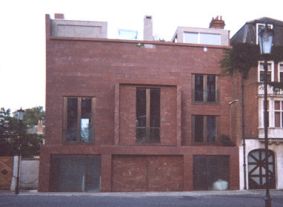
House in Tite Street
District of Chelsea, the heartland of London
The frames are of bronze.
On the garden, the house shows more glazings, mostly in height.
The metal of the balcony appears and there is the same window which breaks the symmetry, already less strict.
The house is elegant but at the same time it is firm and austere because of the materials and the design of the details.
The interiors are white, sober and bright. And, as usual, the corners are soft.
You must love the street, the city and the architecture as you love a woman to mache a house like this.
The Interview:
DV
I am often in London and I would like to get to know and understand this city: in my opinion that means to get in touch with the meaning behind the appearances. Architecture could be a means of comprehension. The Modern Tate or The Great Court of the British Museum let us understand a part of the city. But there is another city, truer and even more difficult to understand : poorer districts, where we can find signs of decay. Right there I saw some interesting architectures, as The Lisson Gallery. From here the idea of this interview for archimagazine.
So, what is London for you?
TF
London is a complex and fractured city, you might say that it is a model of anglo-saxon freemarket capitalism. Within it architects having a social conscience carve out public space and attempt to create intelligent civil spaces.
DV
What kind of relationship is there between your architecture and the part of the city?
TF
In the Lisson gallery from 1992 for example, the very open relationships of the exhibition spaces to the street outside makes them public rooms.
At the house in London completed this year, the facade provides more graded relations between the street and interior, similar to the pallazi in Venice, which allow both close contact and privacy both ways.
The apartment Groningen, also recently completed, draws on typologies that have existed in that city for centuries, which provide some liberty for change by the tenants and known civi relations with the public spaces around them.
All of these buildings draw on shared knowledge and common understandings which provide the rudiments of public social activity.
DV
I visited the Lisson Gallery and I was surprised to find some broken glasses and some stained plaster. Furthermore, the last floor is closed. How do you feel about this carelessness and what is the reason
TF
Well, from the position I have just outlined you have to accept that change will nnot always be as you imagined.
DV
I was struck by the glazed ground floor, as a shop-window. At once it is difficult to understand that it is a Gallery. Which was the idea that gave birth to this choice?
TF
As well as the reasons that I gave before, the facade of the gallery is designed as a kind of sketch of the surrounding buildings. You might say that its forms rhyme with them, not only with the smaller and older building next to it, but with the high rise buildings from the 1960s, and the open spaces which have occurred by chance.
DV
Is there any relationship between the architectural language of the Lisson Gallery and the kind of art in it? I think this relationship was in the original plan, is it true?
TF
I had a powerful empathy with the art that the Lisson was showing when we designed the building, but I am pleased to say that the generation of artists after that empathised with the building!
DV
In what way did your work develop after the Lisson? And what about your most important plans?
TF
My work changes all the time, project by project
DV
Which is the idea behind your work?
TF
The artistry of architecture usefully in contact with society at the level of ideas
DV
How is your office organized and how do you work out a plan from the very first idea to the executive?
TF
I used to design and do everything, now we have an orgabise dofffice in which work is delegated, thanks to my highly talented partner Jim McKinney
DV
I thank you for this meeting. I met an architect whose thought is dynamic and permeable to events. An architect who listens to the places and the history and depicts spaces which have the power to change who comes up to them, as the artists of the Lisson.
We need this today!
London, 8th October 2001